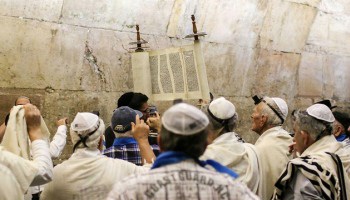Israel and the Divine Presence
I would like to continue the theme that we started on Tu Bishvat and discuss a few more ideas about the Land of Israel. Our Sages tell us that the Divine Presence, the Shechina is found in Israel, more in the city of Jerusalem and even more so at the Western Wall, the Kotel. The Hebrew word Shechinah means “Divine Presence.” Although in reality, G-d permeates all of time and space equally, we are not able to perceive His presence equally in all times and all places. Venice Beach, California, (a completely random example, of course) is a place where the Divine Presence is well concealed, and Super Bowl Sunday is a time when the Divine Presence is difficult to perceive. There are moments when G-d allows us more of a glimpse of the Divine Presence — at sunset towards the end of the Day of Atonement, for instance. There are also places where G-d allows us a greater degree of perception, such as the Land of Israel. The Torah calls Jerusalem the “Gates of Heaven” and our Sages point out that even after the destruction of the Temple, the Divine Presence has never left the Western Wall.
Tens of thousands of Jews from all over the world, representing every level of religiosity, ignorant and learned, Zionist and anti-Zionist, visit the Western Wall every year. The Western Wall, (HaKotel HaMa’aravi or the Kotel) is the westernmost retaining wall of the Temple Mount, and dates from the Second Temple era. Many Jews who visit have no knowledge of the Temple at all, many know little or nothing about Judaism or Jewish history. And yet, the Western Wall draws them like a magnet and often elicits from them deep spiritual feelings. For many people, a single visit to the Western Wall has changed their lives by prompting them to investigate their Jewish roots. We believe that much of this remarkable energy is due to the fact that the “Shechinah never left the Western Wall.”
On the way to Australia from Israel with my two oldest sons, (many years ago) we had a long stopover in Athens. I decided to take the boys to see the Acropolis, one of the most famous and magnificent archaeological sites in the world. On top of the Acropolis, a hill overlooking Athens, stands the Parthenon — a massive pagan temple dedicated to the Greek G-ddess, Athena. I asked my children to compare the Parthenon with the Western Wall. They pointed out that the Parthenon is made of white marble, while the Kotel is made of limestone; the Parthenon is supported by scaffolding and the Kotel stands unassisted. The Kotel has hyssop growing out of it, while the Parthenon is quite bare of vegetation. The most astute observation that they made however, was in their words, “Hey! No one is davening (praying) at the Parthenon!” My children saw through the pomp, the grandeur and the size of the Parthenon. They saw that the Parthenon and what it represented is dead and long gone; Judaism and the Divine Presence that can be felt at the Kotel are living entities. Many tourists visit the Parthenon, but very few, if any, find the same inspiration and feeling of connection that is regularly experienced at the Western Wall. In 1967, towards the end of the Six Day War, when the Kotel returned to Jewish hands after over 2000, years, there was an unprecedented outpouring of emotion from all Israelis. Although rarely articulated, there is a widespread recognition that the Kotel is more than just a place, it is a portal to a spiritual dimension and an opportunity to connect with G-d.
The Torah describes Israel as,
“A land that the Lord, your G-d, seeks out; the eyes of the Lord, your G-d, are always upon it, from the beginning of the year to year’s end.”
The degree to which Divine Providence is manifest in Israel is much greater than anywhere else in the world.
A striking example of the special Divine Providence in Israel is described in the prophecies of exile and redemption. The Torah predicted that the Jews would eventually be exiled from the Land of Israel and that during that time the land would be desolate —
“I will make the land desolate; and your enemies who dwell upon it will be desolate. And you, I will scatter among the nations…”
Two of the great commentators, Rashi and Nachmanides, explain that this ominous prediction is actually a blessing as well. G-d guarantees to the Jewish people that while they are in exile the land will not accept other inhabitants and will remain barren and desolate until their return. In fact, during the period of the first two Jewish commonwealths, the Land of Israel was renowned for its produce, was heavily forested and supported a large population. It was the land accurately described by the Torah as “flowing with milk and honey,” a “land with streams of water, of springs and underground water coming forth in valley and mountain; A land of wheat, barley, grapes, figs, and pomegranates; a Land of oil -producing olives and date- honey.” The Roman-Jewish historian, Josephus Flavius, describes the northern, Galilee, region of Israel as:
…lands, which although they are small in size…, are fertile and have rich pastures… the whole land is cultivated by its inhabitants without even the smallest area left barren, and the cities are populated and plentiful.
Contrast these descriptions with what eyewitnesses wrote about the land when the Jews where in exile. The special connection between the Jewish people and the Land of Israel becomes apparent when we see how precisely the Biblical prophecy has been fulfilled. When Nachmanides immigrated to Israel in the 13th Century he wrote the following letter to his children describing the desolation of Jerusalem:
What shall I tell you about the land? There are so many forsaken places, and the desolation is great. It comes down to this: the more sacred the place, the more it has suffered – Jerusalem is most desolate, Judea more so than the Galilee. Yet in all its desolation it is an exceedingly good land.
When Mark Twain visited Israel (then called Palestine) years later, the landscape was just as bleak:
…a desolate country whose soil is rich enough, but is given over wholly to weeds — a silent mournful expanse…. A desolation is here that not even imagination can grace with the pomp of life and action…. We never saw a human being on the whole route…. There was hardly a tree or a shrub anywhere… Even the olive and the cactus, those fast friends of the worthless soil, had almost deserted the country… No landscape exists that is more tiresome to the eye than that which bounds the approaches to Jerusalem… Jerusalem is mournful, dreary and lifeless. I would not desire to live here. It is a hopeless, dreary, heartbroken land… Palestine sits in sackcloth and ashes.
Today Israel has flowered once again — it exports tulips to Holland, has a thriving, internationally acclaimed wine industry, and produces an incredible variety of fruits, from tropical pineapples, mangos and bananas to cold-climate fruits such as apples and pears. In the Jerusalem forest, a ten minute walk from a number of modern neighborhoods, all the species that flourished in Biblical times, grow wild. Israel’s children have started to come home and the land is proclaiming its welcome. As Ezekiel wrote some 2600 years ago,
“But you, O mountains of Israel, shall give forth your branch and bear your fruit for My people Israel, for they are soon to come.”

